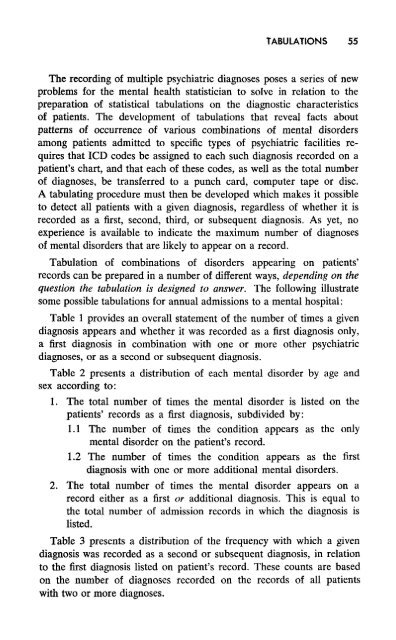DSM+II+1968
DSM+II+1968
DSM+II+1968
You also want an ePaper? Increase the reach of your titles
YUMPU automatically turns print PDFs into web optimized ePapers that Google loves.
20 MENTAL DISORDERS<br />
Hydrocephalus, congenital. Under this heading is included only<br />
that type of hydrocephalus present at birth or occurring soon after<br />
delivery. All other types of hydrocephalus, secondary to other<br />
conditions, should be classified under the specific etiology when<br />
known.<br />
Hypertelorism (Greig's disease). Characterized by abnormal development<br />
of the sphenoid bone increasing the distance between the<br />
eyes.<br />
Macrocephaly (Megalencephaly). Characterized by an increased<br />
size and weight of the brain due partially to proliferation of glia.<br />
Microcephaly, primary. True microcephaly is probably transmitted<br />
as a single autosomal recessive. When it is caused by other conditions<br />
it should be classified according to the primary condition,<br />
with secondary microcephaly as a supplementary term.<br />
Laurence-Moon-Biedl syndrome. Characterized by mental retardation<br />
associated with retinitis pigmentosa, adiposo-genital dystrophy,<br />
and polydactyly.<br />
.5 With chromosomal abnormality<br />
This group includes cases of mental retardation associated with chromosomal<br />
abnormalities. These may be divided into two sub-groups, those<br />
associated with an abnormal number of chromosomes and those with<br />
abnormal chromosomal morphology.<br />
Autosomal trisomy of group G. (Trisomy 21, Langdon-Down disease,<br />
Mongolism). This is the only common form of mental retardation<br />
due to chromosomal abnormality. (The others are relatively rare.)<br />
It ranges in degree from moderate to severe with infrequent cases of<br />
mild retardation. Other congenital defects are frequently present, and<br />
the intellectual development decelerates with time.<br />
Autosomal trisomy of group £.<br />
Autosomal trisomy of group D.<br />
Sex chromosome anomalies. The only condition under the category<br />
which has any significant frequency is Klinefelter's syndrome.<br />
Abnormal number of chromosomes, other. In this category would<br />
be included monosomy G, and possibly others as well as other forms<br />
of mosaicism.<br />
Short arm deletion of chromosome 5—group B (Cri du chat).A<br />
quite rare condition characterized by congenital abnormalities and a<br />
cat-like cry during infancy which disappears with time.


